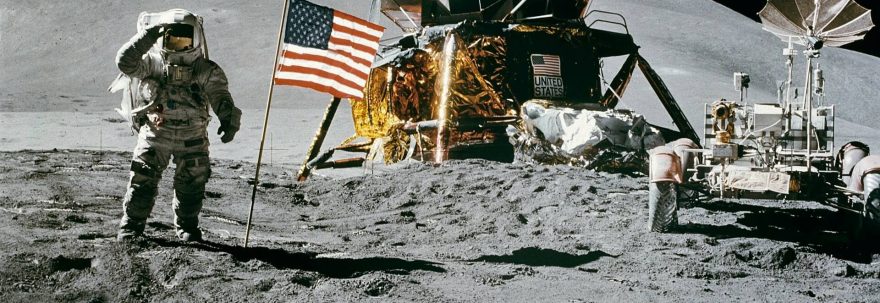A Moon landing is the arrival of a spacecraft on the surface of the Moon. This includes both manned and unmanned robotic missions. The first human-made object to reach the surface of the Moon was the Soviet Union’s Luna 2 mission, on 13 September 1959.
The United States’ Apollo 11 was the first manned mission to land on the Moon, on 20 July 1969. There have been six manned U.S. landings (between 1969 and 1972) and numerous unmanned landings, with no soft landings happening from 22 August 1976 until 14 December 2013.
To date, the United States is the only country to have successfully conducted manned missions to the Moon, with the last departing the lunar surface in December 1972.
After the unsuccessful attempt by the Luna 1 to land on the moon in 1959, the Soviet Union performed the first hard (unpowered) moon landing later that same year with the Luna 2 spacecraft, a feat the U.S. duplicated in 1962 with Ranger 4. Since then, twelve Soviet and U.S. spacecraft have used braking rockets to make soft landings and perform scientific operations on the lunar surface, between 1966 and 1976. In 1966 the USSR accomplished the first soft landings and took the first pictures from the lunar surface during the Luna 9 and Luna 13 missions. The U.S. followed with five unmanned Surveyor soft landings.
The Soviet Union achieved the first unmanned lunar soil sample return with the Luna 16 probe on 24 September 1970. This was followed by Luna 20 and Luna 24 in 1972 and 1976, respectively. Following the failure at launch in 1969 of the first Lunokhod, Luna E-8 No.201, the Luna 17 and Luna 21 were successful unmanned lunar rover missions in 1970 and 1973.
Many missions were failures at launch. In addition, several unmanned landing missions achieved the Lunar surface but were unsuccessful, including: Luna 15, Luna 18, and Luna 23 all crashed on landing; and the U.S. Surveyor 4 lost all radio contact only moments before its landing.
More recently, other nations have crashed spacecraft on the surface of the Moon at speeds of around 8,000 kilometres per hour (5,000 mph), often at precise, planned locations. These have generally been end-of-life lunar orbiters that, because of system degradations, could no longer overcome perturbations from lunar mass concentrations (“masscons”) to maintain their orbit. Japan’s lunar orbiter Hiten impacted the Moon’s surface on 10 April 1993. The European Space Agency performed a controlled crash impact with their orbiter SMART-1 on 3 September 2006.
Indian Space Research Organisation (ISRO) performed a controlled crash impact with its Moon Impact Probe (MIP) on 14 November 2008. The MIP was an ejected probe from the Indian Chandrayaan-1 lunar orbiter and performed remote sensing experiments during its descent to the lunar surface.
The Chinese lunar orbiter Chang’e 1 executed a controlled crash onto the surface of the Moon on 1 March 2009. The rover mission Chang’e 3 was launched on 1 December 2013 and soft-landed on 14 December.

 A blog is a discussion or informational website published on the World Wide Web consisting of discrete, often informal diary-style text entries. Posts are typically displayed in reverse chronological order, so that the most recent post appears first, at the top of the web page.
A blog is a discussion or informational website published on the World Wide Web consisting of discrete, often informal diary-style text entries. Posts are typically displayed in reverse chronological order, so that the most recent post appears first, at the top of the web page.


